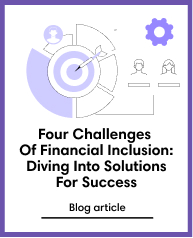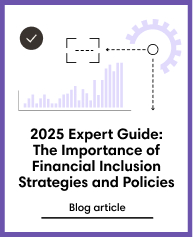Financial Inclusion
May 1, 2019
The Promise of Smartphone Metadata in Financial Inclusion
Subscribe to our newsletter
An estimated 2 billion adults lack formal financial access. To address this gap, banks and non-bank competitors are increasingly offering digital banking solutions and value propositions with lower transaction costs. In fact improving accessibility for under banked will create a significant financial opportunity for banks, and is estimated to generate about $380 billion in annual revenues. However, to effectively sell to this new customer base companies need to generate credit scores that takes into consideration their limitations and uniqueness.
But most companies predominantly rely on static, one-time data of capitals or collaterals or use segmentation approaches, which put many individuals into one unified bucket. Such methods are often inaccurate as consumers may fail or choose not to provide correct and complete demographic data, leading to ambiguous and unreliable dataset. Others like immigrants or recent graduates will lack any such financial history to get formal financial access. So how can banks tap the under banked while ensuring higher approval and lower delinquency rate?
Turn Unbanked Customer into Profitable Customer with Alternative Data Sources
The key to transform non-banking customers into profitable customers –is through behavioural insights that are related to the willingness to pay back a loan, such as loyalty, consistency of behaviour and ethical standards. Today studies have proved that anonymous smartphone metadata can be easily extrapolated to provide meaningful insight into borrower’s behaviour. For instance, prompt bill payers are typically more reliable than those who hold off. In addition, companies can predict user behaviour and their intention to pay back by studying patterns of daily mobile usage.
By applying scoring algorithms to anonymous metadata banks can create robust personalised models of human behaviour in social, spatial, and sequential contexts. What’s more? Large-scale phone-based metadata with behavioural mapping abilities empowers organisations to not only infer financial findings about health and social wellbeing of the potential customers but also infer financial wellbeing based on spending pattern. The anonymity of the data is a bonus at a time when data privacy is one of major concerns for banks and customers alike.
Take lesson from leading companies such as Tata Capital and IDFC banks are already leveraging alternative data to evaluate customers credit worthiness. The new parameters set by metadata analysis has helped them make credit underwriting easier and enhance short-term loans decisions.
Transform Financial Inclusion Opportunity into Improved MarketShare
There has never been a better time for banks to increase profits by being more financially inclusive. Lending to unbanked customers not only boosts organization’s brand image but also has a positive impact on financial institutions’ bottom line. Metadata offers safe and effective way to predict customer’s behaviour (without invading customer’s privacy), making the entire lending process fast, seamless and paperless. The end result: enhanced customer base and significant market traction with high return on assets (ROA).





